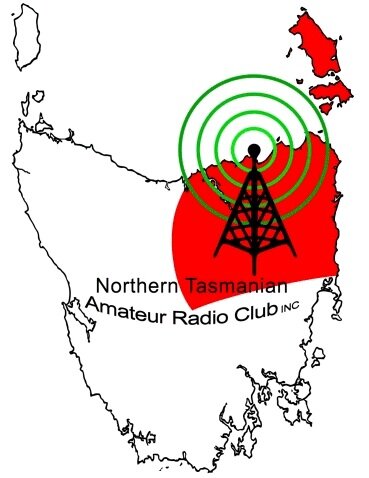Broadcast - 6 April 2025
At the Technical Night held in the Club Rooms on Wednesday saw Andrew VK7DW, give a short presentation on the “Fram2Ham” Slow Scan TV simulation tests conducted from the International Space Station or ISS earlier this year. These tests were designed to “simulate the challenges and unknowns” of transmitting 70 cm SSTV images hopefully from a Dragon capsule in the near future.
However since Andrew volunteered to conduct a presentation the game had changed, but more on that later.
Andrew covered aspects of the International Space Station simulation of the future mission, namely:
5 Watts versus the normal 25 Watt transmit power.
Images to be sent on 70 cm rather than 2 metre band, allowing ground users to practice the more challenging faster and wider Doppler correction requirements.
The longer image capture for this simulation (120 seconds, verses 36 seconds for Fram2Ham’s Robot 36 SSTV mode. This was to allow ground users to hone their signal polarisation switching skills, both manually and electronically, as well as precise antenna pointing.
The ISS travels West to East as opposed to the SpaceX Dragon FRAM2 will be on a Polar or North / South Pole orbit.
The all-important how to track satellites using programs like “Gpredict”, Websites with important flight information and possibly the most important, the updating of the software’s TLE or Two Line Elements file, often referred to as Keplerian elements. This allows your satellite tracking software to present you with orbital receiving information relevant to your location on the earth.
Andrew then covered the audio Recording of the Transmission, Doppler and Polarisation correction and polarisation changes required. Completing this section with the submitting of uploaded loaded images to the gallery and applying for an Award. Andrew then presented us with half a dozen images that he had successfully decoded from the ISS tests and his ARRISS SSTV Award of achievement.
Now for the “Icing on the Cake”, within a day or so of his presentation Andrew learned that the actual SpaceX Dragon had just launched on its FRAM2 mission. With the TLE files quickly loaded, the ones to find out when and where to point the antenna basically, Andrew soon learned that a lot of good orbital passes clashed very badly with that thing called “your daily job”. HiHi
Funnily enough the next potentially good orbit for decoding was the night of the presentation at about 21:39. So needless to say Andrew didn’t hang around long after the presentation, a quick drink and off. I have no idea of the outcome yet but fingers crossed.
The main take home of the second part of the presentation was:
Transmission frequency of 437.550MHz +- 10kHz Robot36 SSTV FM.
Twelve SSTV image transmissions were to be in random order.
Images are combined to represent three geographical locations relating to polar exploration, with four images making up each location.
There will approximately be a three day transmission window with only a limited time assigned for the SSTV operation.
Astronaut and radio amateur Rabea Rogge LB9NJ / KD3AID, will transmit the SSTV images from the SpaceX Dragon.
There is an excellent link to AMSAT – UK included in the text version of this broadcast. (https://amsat-uk.org)
By the time this goes to air the three day mission will have ended and the SpaceX Dragon with its crew will hopefully have safely splashed down in the Pacific Ocean…..
Now for a real “Stop Press”, as I was penning this article on Friday afternoon, I had to stop!
The reason being was to listen to ABC Local Radio. There was an interview with Andrew VK7DW live to air covering the Dragon FRAM2 Slow Scan TV experiment.
This was an Excellent interview Andrew, you certainly conveyed the relevant information, including some hard to explain concepts, simply and in a digestible format for the listening audience, well done.
At least this week I can blame somebody else for sending in our State-Wide broadcast notes late, sorry Justin. HiHi
As always pictures will be available on the NTARC Web site under “Blogs” for this broadcast. NTARC Blogs
UPCOMING EVENTS
TestNet and TechNet session - Every Wednesday, TestNet/CW course on 3.580MHz from 7 pm, then a TechNet on 3.567MHz from 7.30 pm till 8.30 pm. Your host for the evening is Nic VK7WW.
Club Room Technical night session – The next session will be on Wednesday the 16th April, at the usual time of 6.30 pm at the Club Room Archer Street, Rocherlea.
Coffee Morning – will be held this Friday in the NTARC Club rooms. Time is from 10 am to noon and we look forward to seeing you all there. Please note there will be no Friday coffee mornings on Easter Friday and Anzac Day. That’s no coffee morning on the 18th and the 25th of April.
Finally - A reminder to all members that if you have any items of news you would like added to our weekly roundup, no matter how trivial, then please email them to the Secretary at the following address news@ntarc.net all items to be received no later than 5 pm on the Friday prior to the Broadcast.
That’s all folks,
73, Stefan VK7ZSB, Secretary NTARC Inc.
